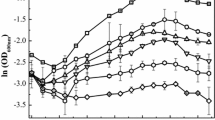Summary
In order to get information about the mechanism of action of alkylating agents, survival was studied after treatment with methyl methanesulfonate, in an arginine-requiring strain of the unicellular green algaChlamydomonas reinhardi. Methylated cells are susceptible to further degradation if they are allowed to stand at ordinary temperature and are differentially sensitive to heating in buffer at 40° C. The heat sensitivity of the cells is greatly reduced if they are incubated overnight in the dark, irrespective of the medium (buffer, minimal medium-supplemented or not-or complete medium). The results are interpreted by assuming that some primary damage remains in the cell after the treatment and that this may be converted into actual damage. This conversion is favoured by drastic conditions of post-treatment, immediately and before the occurrence of recovery from primary damage.
Similar content being viewed by others
References
Alexander, P., andJ. T. Lett: The biological significance of the changes produced in the deoxyribonucleic acid of cells treated with radiomimetic alkylating agents. Les Congrès et Colloques de l'Université de Liège 1959.
——, andG. Parkins: Instability of alkylated deoxyribonucleic acid in relation to the mechanism of chemical mutagenesis. Biochim. biophys. Acta (Amst.)48, 423–425 (1961).
Bautz, E., andE. Freese: On the mutagenic effect of alkylating agents. Proc. nat. Acad. Sci. (Wash.)46, 1585–1594 (1960).
Boyce, R. P., andP. Howard-Flanders: Genetic control of DNA breakdown and repair inE. coli K-12 treated with mitomycin C or ultraviolet light. Z. Vererbungsl.95, 345–350 (1964).
Brookes, P., andP. D. Lawley: The reaction of mono- and di-functional alkylating agents with nucleic acids. Biochem. J.80, 496–503 (1961).
Hanawalt, P., andR. Haynes: Repair replication of DNA inbacteria: irrelevance of chemical nature of base defect. Biochem. biophys. Res. Commun.19, 462–467 (1965).
Hutner, S. H., L. Provasoli, A. Schatz, andC. P. Haskins: Some approaches of the study of the role of metals in the metabolism of microorganisms. Proc. Amer. Phil. Soc.94, 152–170 (1950).
Kimball, R. F.: The induction of reparable premutational damage inParamecium aurelia by the alkylating agent triethylene melamine. Mut. Res.2, 413–425 (1965).
Krieg, D. R.: Ethyl methanesulfonate induced reversion ofbacteriophage T 4 r II mutants. Genetics48, 561–580 (1963).
Lawley, P. D.: The hydrolysis of methylated deoxyguanylic acid at pH 7 to yield 7-methyl-guanine. Proc. Chem. Soc.1957, 290–291.
—, andP. Brookes: Molecular mechanism of the cytotoxic action of difunctional alkylating agents and of resistance to this action. Nature (Lond.)206, 480–483 (1965).
Lett, J. H., G. M. Parkins, andP. Alexander: Physicochemical changes produced in DNA after alkylation. Arch. Biochem.97, 80–93 (1962).
Levine, R. P., andW. T. Ebersold: The genetics and cytology ofChlamydomonas. Ann. Rev. Microbiol.14, 197–216 (1960).
Loveless, A., J. Cook, andP. Wheatley: Recovery from the lethal effects of cross-linking alkylation. Nature (Lond.)205, 980–983 (1965).
—,andJ. C. Stock: The influence of radiomimetic substances on deoxyribonucleic acid synthesis and function studied inEscherichia coli/phage system. I. The nature of inactivation ofT 2 phage in vitro by certain alkylating agents. Proc. roy. Soc.B 150, 423–445 (1959).
Ludlum, D. B.: Alkylation of polynucleotide complexes. Biochim. biophys. Acta (Amst.)95, 674–676 (1965).
—,R. C. Warner, andA. J. Wahba: Alkylation of synthetic polynucleotides. Science145, 397–399 (1964).
Peters, R. A.: Hormones and the cytoskeleton. Nature (Lond.)177, 426 (1956).
Reiner, B., andS. Zamenhof: Studies on the chemically reactive groups of deoxyribonucleic acid. J. biol. Chem.228, 475–486 (1957).
Reiter, H., andB. Strauss: Repair of damage induced by a monofunctional alkylating agent in a transformable, ultraviolet-sensitive strain ofBacillus subtilis. J. molec. Biol.14, 179–194 (1965).
Rupert, C. S.: Repair of ultraviolet damage in cellular DNA. J. cell. comp. Physiol.58, Suppl.1, 57–68 (1961).
Strauss, B. S.: Production of a permeability defect inEscherichia coli by the mutagenic alkylating agent, ethylsulfate. J. Bact.81, 573–580 (1961).
—: Response ofEscherichia coli auxotrophs to heat after treatment with mutagenic alkyl methanesulfonates. J. Bact.83, 241–249 (1962).
—: Differential destruction of the transforming activity of damaged deoxyribonucleic acid by a bacterial enzyme. Proc. nat. Acad. Sci. (Wash.)48, 1670–1675 (1962).
—, Recovery of deoxyribonucleic acid from the effects of alkylation. J. gen. Microbiol.30, 89–103 (1963).
—, andR. Wahl: The presence of breaks in the deoxyribonucleic acid ofBacillus subtilis treatedin vivo with the alkylating agent, methyl methanesulfonate. Biochim. biophys. Acta (Amst.)80, 116–126 (1964).
Sueoka, N.: Mitotic replication of deoxyribonucleic acid inChlamydomonas reinhardi. Proc. nat. Acad. Sci. (Wash.)83, 83–91 (1960).
Author information
Authors and Affiliations
Rights and permissions
About this article
Cite this article
Loppes, R. Damage induced by methyl methanesulfonate (MMS) inChlamydomonas reinhardi . Zeitschrift für Vererbungslehre 98, 193–202 (1966). https://doi.org/10.1007/BF00888947
Received:
Issue Date:
DOI: https://doi.org/10.1007/BF00888947




